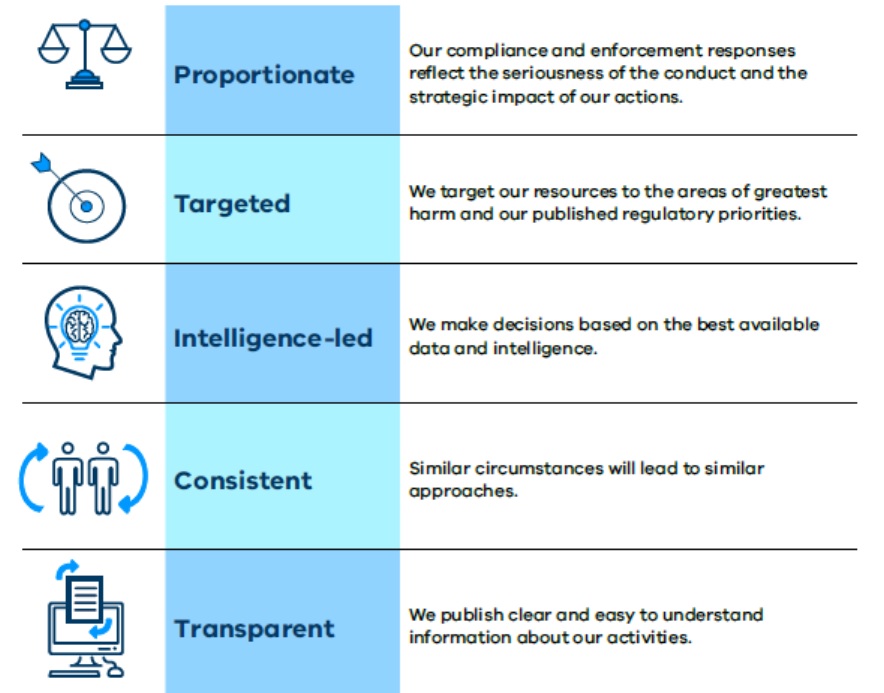Compliance and Enforcement
Compliance and Enforcement approach
The VBA’s Compliance and Enforcement Policy Framework explains how the regulator enforces compliance in building and plumbing work. It sets out how the regulator uses its powers under the Building Act 1993 (the Act) to protect consumers and improve building safety in Victoria.
The VBA applies a risk-based approach to responding to non-compliance and disciplining, and as needed, removing rogue practitioners from the building system. The most extreme measures apply to flagrant disregard for compliance with the Act, regulations and standards, which put consumers and property at risk.
The Compliance and Enforcement Policy Framework (PDF, 1142.02 KB) (Our Approach (PDF, 1181.84 KB)) outlines what the regulator expects from practitioners and what practitioners and the community can expect from it. It sets out how regulatory powers are used and how compliance is enforced. It also outlines how the regulator educates and communicates to those it licences and registers, to improve standards of performance and the quality of building and plumbing in the industry overall.
This framework underpins and complements the VBA’s Regulatory Policy Statement, which sets out the approach to harms mitigation in building and plumbing across Victoria.
A shared regulatory environment
Building and plumbing compliance starts with the practitioners responsible for the work. Builders and plumbers have duties and obligations around compliance of the work they do, supervise or sign off. Building work is subject to mandatory inspections, mainly done by the private building surveyor, appointed by the building owner. Licensed plumbers have a self-certification role that is underwritten by a plumbing insurance scheme.
The VBA’s role is to:
- Monitor the work of builders, plumbers, and others with duties,
- Ensure compliance standards are met,
- Investigate when they are not, and
- Use the full suite of regulatory powers, to impose proportionate corrective and disciplinary measures when a breach has occurred.
The VBA works closely with industry in the spirit of shared responsibility.
The VBA recognises the important role industry associations and professional bodies play in informing their members with up-to-date information including changes to legislation, standards and the National Construction Code.
An industry-wide approach to regulation
The VBA scrutinises practitioners entering the industry through robust licensing and registration processes, and the ongoing oversight and enforcement of obligations associated with that role.
To ensure maximum positive impact on compliance, the regulator:
- Audits and inspects higher-risk plumbing or building businesses based on available data and intelligence.
- Holds registered builders and plumbers to account for the work they are required to supervise.
- Publicises when practitioners practice is in breach of obligations.
- Recognises the contribution of industry associations and of professional bodies in supporting practitioners’ compliance.
Compliance and enforcement principles
The VBA’s compliance and enforcement principles put the Act’s objectives into practice.

What consumers can expect from the VBA
The VBA addresses consumer risks using a harms-based approach to prioritising reported building and plumbing non-compliance, as outlined in legislation. This role includes promoting the resolution of consumer complaints about noncompliant work and providing information and advice to consumers.
The regulator draws on intelligence from peer regulators, advocacy bodies, registered practitioners and industry to identify and act firmly on unlawful work.
Confusion can arise between what is poor-quality work and non–compliance within the Act. Where there is no Building Act 1993 non-compliance with safety or building integrity risks, and or general contract disputes between an owner and a builder, the VBA has no power to take action or enforce penalties.
What the VBA expects from practitioners
The VBA expects practitioners to engage with their regulatory obligations openly and constructively.
This can be in field interactions, providing clear and transparent information when responding to requests, in showing cooperation when we are investigating a matter, and when acting in a timely way to rectify their mistakes.
Our tools and powers
The VBA uses its regulatory tools and powers for maximum positive impact on individual practitioners and overall industry performance. This includes:
- Intentional and consistent use of different disciplinary tools including education, suspensions, cancellations, disqualifications, monetary penalties, review of licences and registrations, and other tools.
- How we communicate disciplinary outcomes and legal proceedings to inform consumers and other practitioners.
The VBA has a range of tools to:
- Educate practitioners,
- Ensure practitioners correct non-compliance, and
- Impose fines or other disciplinary outcomes to address poor practitioner behaviour.
The tools available depend on the type of work, the seriousness of the non-compliance, and the timeframes when the non-compliance is detected.
The Compliance and Enforcement Policy Framework (PDF, 1142.02 KB) (Our Approach (PDF, 1181.84 KB)) explains when these may be applied.
Regulatory focus recognises past behaviour and engagement
While monitoring all risks, the VBA accounts for past performance when deciding how to allocate compliance and enforcement resources.
The regulator focuses additional effort on practitioners who have demonstrated a low ability or willingness to comply, who do not have robust systems to ensure quality, or who give rise to multiple consumer reports.
More attention is given to businesses who do not adequately oversee work and practitioners, or who tolerate poor understanding by employees or supervised staff.
Compliance monitoring and enforcement responses will focus less on those who have a history of strong performance, have fit-for-purpose policies and procedures and who act on issues raised.
We also act on isolated serious breaches of the Act and standards, and take enforcement action against all non-compliances that undermine the integrity of the building and plumbing regulatory framework.
